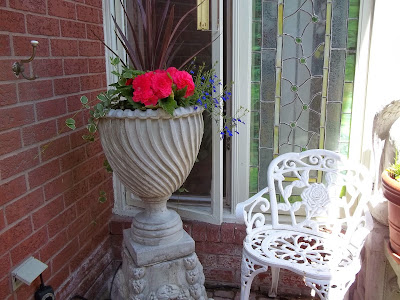Yesterday we had a light snowfall. Enough to restore the early-winter snowpack to the depth it had acquired before several days of above-freezing temperature reduced it somewhat. And enough to ensure that it would have to be shovelled away, off the walkways and off the driveway. Some freezing rain came down afterward, which turned again into light snow by evening and overnight. More, much more to come.
But since then, it has turned considerably colder, and we're continually reminded by these alternations how changeable weather in this part of Canada can be. And that we'd better hang in there, since winter has not yet really started. More, much more to come.
When it's really cold, I mean frigid, the rhododendrons in the garden react. For their first ten years of life in the garden they were always covered with winter garden blankets to preserve their life over-winter. I haven't covered them in years now. And I remember that when we used to hike in the winter in Georgia in forested 'mountain' areas, the rhododendrons and the wild magnolia which never lost their leaves there as they do here, used to react to extreme cold (although never as 'extreme' as what we are accustomed to) by shrivelling, reducing the area of their leaves in effect, to try to protect themselves.
And this is what our rhododendrons do on very cold days. Looking exquisitely miserable in the process. And then, when more moderate days come along they brighten up, loosen the grip on the leaf surface and open up flat again, looking quite composed. The magnolias, which do lose their foliage in this geographic area, have hundreds of flower buds that developed in late summer. They're fuzzy and promising of great form and colour come spring, when they'll begin growing in size until they burst into flower.
I've also noticed something quite touching. In the late spring we plant all of our urns and garden pots with what in our climate are annuals, but in more temperate climates are perennials. Among the flowers we usually plant fillers like vines for additional texture, colour and contrast. The vinca vines, I noticed a long time ago, have a tendency to send down roots if the vines happen to grow long enough, and plants become established in the garden, through those stray bits that root.
On the porch we have an urn whose contents are emptied in preparation for the long winter months, in late fall, when the 'annuals' are not equipped by their origins to cope with extreme cold become limp and frozen. Up come those I can overwinter and re-introduce the following spring. It hadn't occurred to me to do this with any of the vines; much too fussy and time- and space-consuming.
And then, months ago, I noticed that on the bottom left-hand corner of the porch there was a tiny, sturdy little vine growing. When the weather becomes extremely frigid, its leaves pucker and draw themselves together just as the rhododendron leaves do. And when the weather takes a moderate turn, the little vinca leaves bravely broaden out again. Obviously, that tiny bit of vine, left over from the time that I clear out all the plants in the fall, had established itself through a root system it developed and now lives, determinedly, between the bricks and mortar of the side of our house. Long may it live!



No comments:
Post a Comment